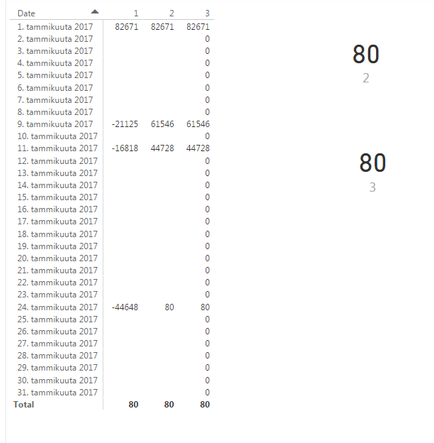- Power BI forums
- Updates
- News & Announcements
- Get Help with Power BI
- Desktop
- Service
- Report Server
- Power Query
- Mobile Apps
- Developer
- DAX Commands and Tips
- Custom Visuals Development Discussion
- Health and Life Sciences
- Power BI Spanish forums
- Translated Spanish Desktop
- Power Platform Integration - Better Together!
- Power Platform Integrations (Read-only)
- Power Platform and Dynamics 365 Integrations (Read-only)
- Training and Consulting
- Instructor Led Training
- Dashboard in a Day for Women, by Women
- Galleries
- Community Connections & How-To Videos
- COVID-19 Data Stories Gallery
- Themes Gallery
- Data Stories Gallery
- R Script Showcase
- Webinars and Video Gallery
- Quick Measures Gallery
- 2021 MSBizAppsSummit Gallery
- 2020 MSBizAppsSummit Gallery
- 2019 MSBizAppsSummit Gallery
- Events
- Ideas
- Custom Visuals Ideas
- Issues
- Issues
- Events
- Upcoming Events
- Community Blog
- Power BI Community Blog
- Custom Visuals Community Blog
- Community Support
- Community Accounts & Registration
- Using the Community
- Community Feedback
Register now to learn Fabric in free live sessions led by the best Microsoft experts. From Apr 16 to May 9, in English and Spanish.
- Power BI forums
- Forums
- Get Help with Power BI
- Desktop
- Re: Sum of cumulative inventory / sum of measure
- Subscribe to RSS Feed
- Mark Topic as New
- Mark Topic as Read
- Float this Topic for Current User
- Bookmark
- Subscribe
- Printer Friendly Page
- Mark as New
- Bookmark
- Subscribe
- Mute
- Subscribe to RSS Feed
- Permalink
- Report Inappropriate Content
Sum of cumulative inventory / sum of measure
Hi!
At the moment my matrix looks like this (tammikuu = january):
Column 1 shows the values that my fact table has (Inventory changes).
Column 2 is a cumulative measure of those changes:
2 = CALCULATE (
SUM ( Fact[value]);
FILTER (
ALL (CalendarTable[Date]);
CalendarTable[Date] <= MAX ( Fact[date] )
)
)And column 3 is the problematic one.
Basically I have 2 questions/problems:
1. At the moment every row that doesnt have a cumulative value is shown as 0, but I would like it to be as follows:
| 1.1.2017 | 82671 | 82671 |
| 2.1.2017 | 82671 | |
| 3.1.2017 | 82671 | |
| 4.1.2017 | 82671 | |
| 5.1.2017 | 82671 | |
| 6.1.2017 | 82671 | |
| 7.1.2017 | 82671 | |
| 8.1.2017 | 82671 | |
| 9.1.2017 | -21125 | 61546 |
| 10.1.2017 | 61546 | |
| 11.1.2017 | -16818 | 44728 |
| 12.1.2017 | 44728 | |
| 13.1.2017 | 44728 | |
| 14.1.2017 | 44728 | |
| 15.1.2017 | 44728 | |
| 16.1.2017 | 44728 | |
| 17.1.2017 | 44728 | |
| 18.1.2017 | 44728 | |
| 19.1.2017 | 44728 | |
| 20.1.2017 | 44728 | |
| 21.1.2017 | 44728 | |
| 22.1.2017 | 44728 | |
| 23.1.2017 | 44728 | |
| 24.1.2017 | -44333 | 395 |
| 25.1.2017 | 395 | |
| 26.1.2017 | 395 | |
| 27.1.2017 | 395 | |
| 28.1.2017 | 395 | |
| 29.1.2017 | 395 | |
| 30.1.2017 | 395 | |
| 31.1.2017 | 395 |
2. I also need a sum of the third column (in this case 1369084) because in the end I want to calculate the average of the month (1369084/31).
All help and tips are much appreciated!
Solved! Go to Solution.
- Mark as New
- Bookmark
- Subscribe
- Mute
- Subscribe to RSS Feed
- Permalink
- Report Inappropriate Content
In this scenario, you can add a calculated column to return same result as @Vvelarde's approach.
Column =
CALCULATE (
SUM ( Table2[value] ),
FILTER ( Table2, Table2[Date] <= EARLIER ( Table2[Date] ) )
)
Then you can sum those values properly.
- Mark as New
- Bookmark
- Subscribe
- Mute
- Subscribe to RSS Feed
- Permalink
- Report Inappropriate Content
hi, Point 1:
Running total =
CALCULATE (
SUM ( 'Table2'[Value] );
ALLSELECTED ( Table2[Value] );
FILTER (
ALLSELECTED ( 'Table2'[Date] );
ISONORAFTER ( 'Table2'[Date]; MAX ( 'Table2'[Date] ); DESC )
)
)

Lima - Peru
- Mark as New
- Bookmark
- Subscribe
- Mute
- Subscribe to RSS Feed
- Permalink
- Report Inappropriate Content
- Mark as New
- Bookmark
- Subscribe
- Mute
- Subscribe to RSS Feed
- Permalink
- Report Inappropriate Content
Helpful resources

Microsoft Fabric Learn Together
Covering the world! 9:00-10:30 AM Sydney, 4:00-5:30 PM CET (Paris/Berlin), 7:00-8:30 PM Mexico City

Power BI Monthly Update - April 2024
Check out the April 2024 Power BI update to learn about new features.

| User | Count |
|---|---|
| 107 | |
| 98 | |
| 78 | |
| 65 | |
| 53 |
| User | Count |
|---|---|
| 144 | |
| 104 | |
| 100 | |
| 86 | |
| 64 |


